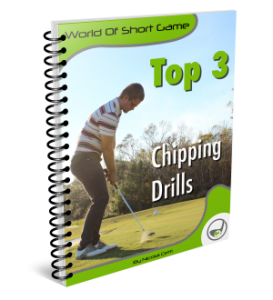- +4527976587
- mail@worldofshortgame.com

How to Choose the Right Chip Shot in Golf

How to Choose the Right Chip Shot in Golf
How to Choose the Right Chip Shot in Golf: A Step-by-Step Guide
Chipping around the greens is one of the most important skills in golf. Selecting the right shot can make the difference between a good up-and-down and leaving yourself with a long putt. This article will provide a comprehensive breakdown of how to choose the right chip shot in golf, covering everything from evaluating the lie to picking your landing spot and matching the shot’s height to the conditions. By mastering this process, you’ll improve your consistency and lower your scores.
Step 1: Evaluate the Lie
The first step in selecting the right chip shot is to evaluate the lie. Understanding the lie allows you to determine your options and adjust your shot accordingly. Here are the key factors to consider:
A. Is the Clubhead’s Path Clear?
The first thing to determine is whether your clubhead has a clear path to the ball. Ask yourself if there are any obstacles, such as thick grass, rough, dirt, or rocks that could interfere with your swing.
Looking to improve your short game? I'm currently offering online lessons through the Skillest app with a 50% discount on your first lesson for all readers of the World of Short Game blog. Simply use the promo code "WOSG50percent" when booking your first session to get started at a discounted rate. Let’s work on your game together! ⛳️
- Free Path: If the club has a clear path, you can stick to a standard chip shot without adjusting too much.
- Obstructed Path: If there are obstacles, you may need to modify your swing by steepening the attack angle or increasing clubhead speed to power through any grass or rough.
B. How Much Grass Is Between the Ball and the Clubface?
Next, evaluate how much grass will be trapped between the ball and the clubface. The more grass, the more it will impact the ball’s speed, height, and spin.
- More Grass: The ball will come off with less speed, less spin, and will typically fly higher. You’ll need to add more speed to compensate.
- Less Grass: The ball will respond more predictably, and you can execute the shot with your normal speed and mechanics.
C. Where Is the Ball Relative to the Ground?
Finally, check how the ball is positioned in the grass. Is it sitting high or low in the rough, or nestled down close to the ground?
- High in the Grass: Be cautious with opening the clubface too much, as it might slide underneath the ball. You may need to grip slightly lower on the club to ensure good contact.
- Low in the Grass: If the ball is sitting deep in the grass, avoid using too much loft or opening the clubface, as this can lead to a bladed shot.
Adjust Your Shot Based on the Lie
Once you’ve evaluated the lie, you’ll have a better sense of what shots are possible. For example, if the lie is clean, you might have the option to play a higher trajectory shot. However, a poor lie may limit your choices to a lower, running chip.
Step 2: Pick the Best Landing Spot
Once you’ve evaluated the lie, the next step is to choose the right landing spot. This will dictate where you want the ball to hit the green before it rolls out toward the hole. Your landing spot is crucial for controlling distance and ensuring that the ball ends up near the target.
A. Visualizing the Shot
A key part of picking the right landing spot is visualizing the entire shot. Imagine how the ball will behave once it hits the green—how much it will roll and in what direction. Consider the slope and speed of the green to get a better sense of where you want the ball to land.
- Short Chips: If you’re closer to the hole, you’ll want the ball to land softly and not roll too far. Choose a landing spot nearer to the hole, and use a higher lofted club to control the rollout.
- Longer Chips: For longer chips, the ball will need to travel further in the air and roll more. Pick a landing spot that allows for sufficient roll and take into account the slope and green speed.
B. Match the Lie with the Landing Spot
The landing spot you choose should also reflect the lie you’re dealing with. For example, if the ball is sitting up in the rough and you plan to hit a high shot, you may need a closer landing spot. If the lie is tight, you might need to pick a spot further away to let the ball roll more.
C. Factors Affecting the Landing Spot
When picking your landing spot, consider these factors:
- Green Speed: Faster greens will require a landing spot closer to you, while slower greens may allow for a spot farther away.
- Slope of the Green: Landing on an uphill or downhill slope will affect how much the ball rolls out.
- Wind Conditions: Wind can influence how the ball behaves once it lands on the green, so keep that in mind as well.
For more details on the topic of Landingspot, you should read the article “How to Choose the Right Landing Spot When Chipping”
Step 3: Match the Height of the Shot to the Landing Spot
After evaluating the lie and choosing your landing spot, the final step is to match the height and trajectory of your shot to the landing spot. The height of the shot will determine how much the ball rolls out after landing, so this step is crucial for getting the ball close to the hole.
A. Higher Shots for Softer Landings
If you need the ball to stop quickly, opt for a higher trajectory. Higher shots land softly and roll less, making them ideal for tight pins or when there’s little room to work with.
- How to Hit High Shots: Open the clubface slightly and set the ball farther forward in your stance. Use a wedge with more loft, such as a sand or lob wedge.
B. Lower Shots for More Roll
Lower shots tend to roll more after they land. This is useful when you need the ball to travel a longer distance after hitting the green, or when the pin is located further away.
- How to Hit Low Shots: Use a less-lofted club, like a pitching wedge or 9-iron. Set the ball slightly farther back in your stance and keep the clubface more square to reduce loft.
C. Adjust Based on Conditions
There are several conditions that can affect how the ball reacts after landing:
- Green Hardness: On firm greens, expect the ball to roll out more, even on higher shots. On softer greens, the ball will stop more quickly.
- Wind: Wind can either hold the ball up or push it down, affecting the ball’s flight and how it rolls after landing.
- Slope: Pay close attention to the slope of the green. A downhill slope will cause the ball to roll out much farther than an uphill slope.
If you want to learn more about hitting the ball higher, read the article How to Hit High Chip Shots, and for lower shots you should read 4 Chipping Tips for Lower Trajectory Shots.
Practice Tips for How to choose the right chip shot in golf
The ability to consistently choose the right chip shot comes with practice and experience. Here are a few tips to help you refine your shot selection process:
A. Practice Landing Spot Drills
Set up landing zones on the practice green and focus on hitting shots that land in those areas. By practicing this, you’ll get a better sense of how different shots behave based on trajectory and roll.
B. Experiment with Different Lies
Practice chipping from various lies, such as deep rough, tight fairways, and uphill or downhill slopes. By practicing from different conditions, you’ll gain confidence in evaluating lies and adjusting your shot accordingly.
C. Work on Visualization
Develop your visualization skills by watching how the ball flies and rolls during practice. The better you can visualize the shot, the more accurate your shot selection will be during actual play.
Conclusion on How to choose the right chip shot in golf
Choosing the right chip shot is a skill that requires a combination of lie evaluation, precise landing spot selection, and trajectory control. By mastering these three steps, you’ll significantly improve your short game, lower your scores, and increase your consistency around the green.
Next time you’re faced with a tricky chip, remember to:
- Evaluate the lie and determine your options.
- Pick the best landing spot, considering green speed, slope, and wind.
- Match the shot’s height to the landing spot, adjusting for conditions.
With practice, you’ll be able to make smarter decisions and execute your chip shots with confidence.
Remember, If you are new to the game of golf, you should checkout the beginners-universe called Golf For Beginners Academy. They provide the best content for beginner golfers!
Looking to improve your short game? I'm currently offering online lessons through the Skillest app with a 50% discount on your first lesson for all readers of the World of Short Game blog. Simply use the promo code "WOSG50percent" when booking your first session to get started at a discounted rate. Let’s work on your game together! ⛳️
You must be logged in to post a comment.



